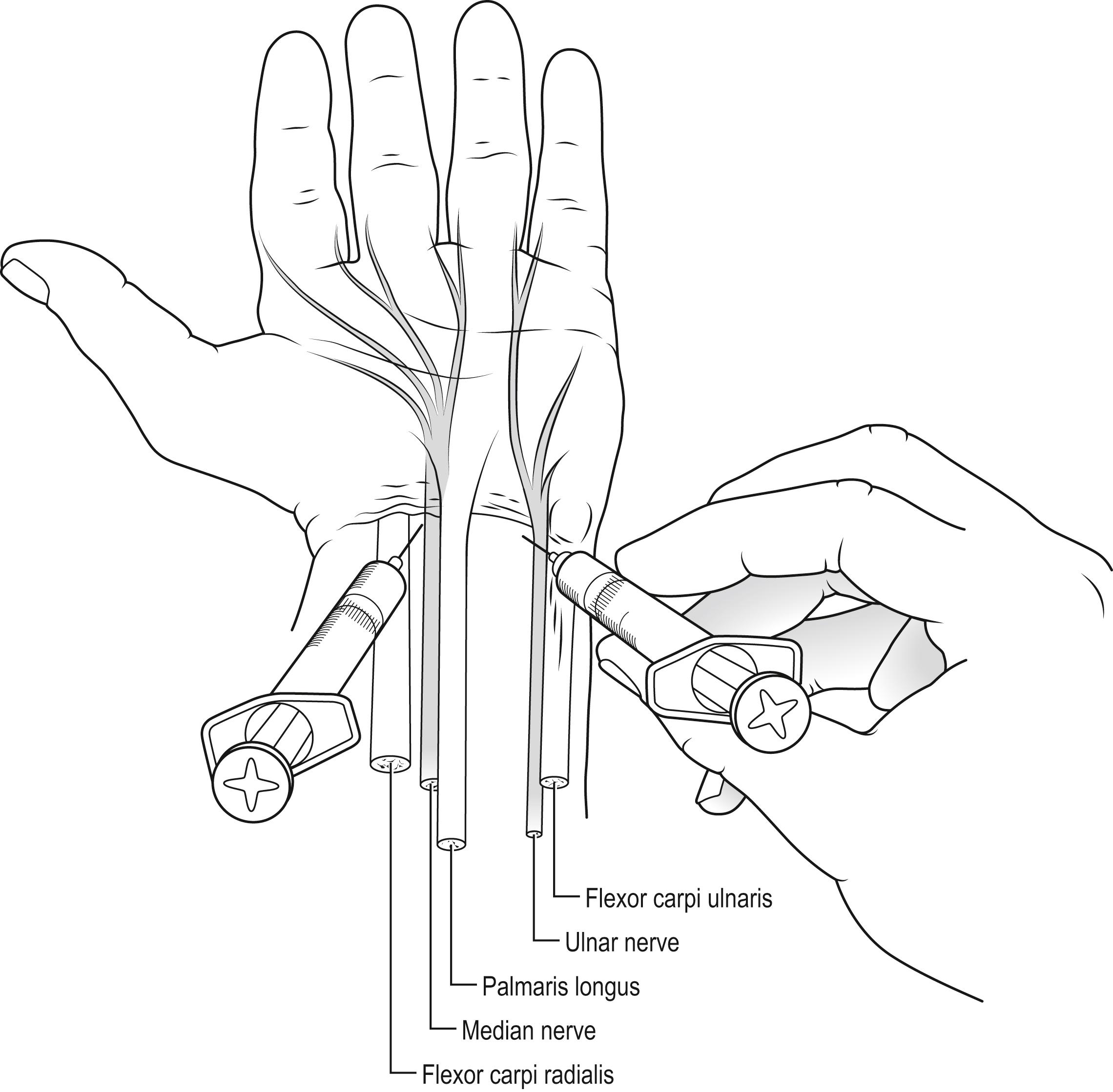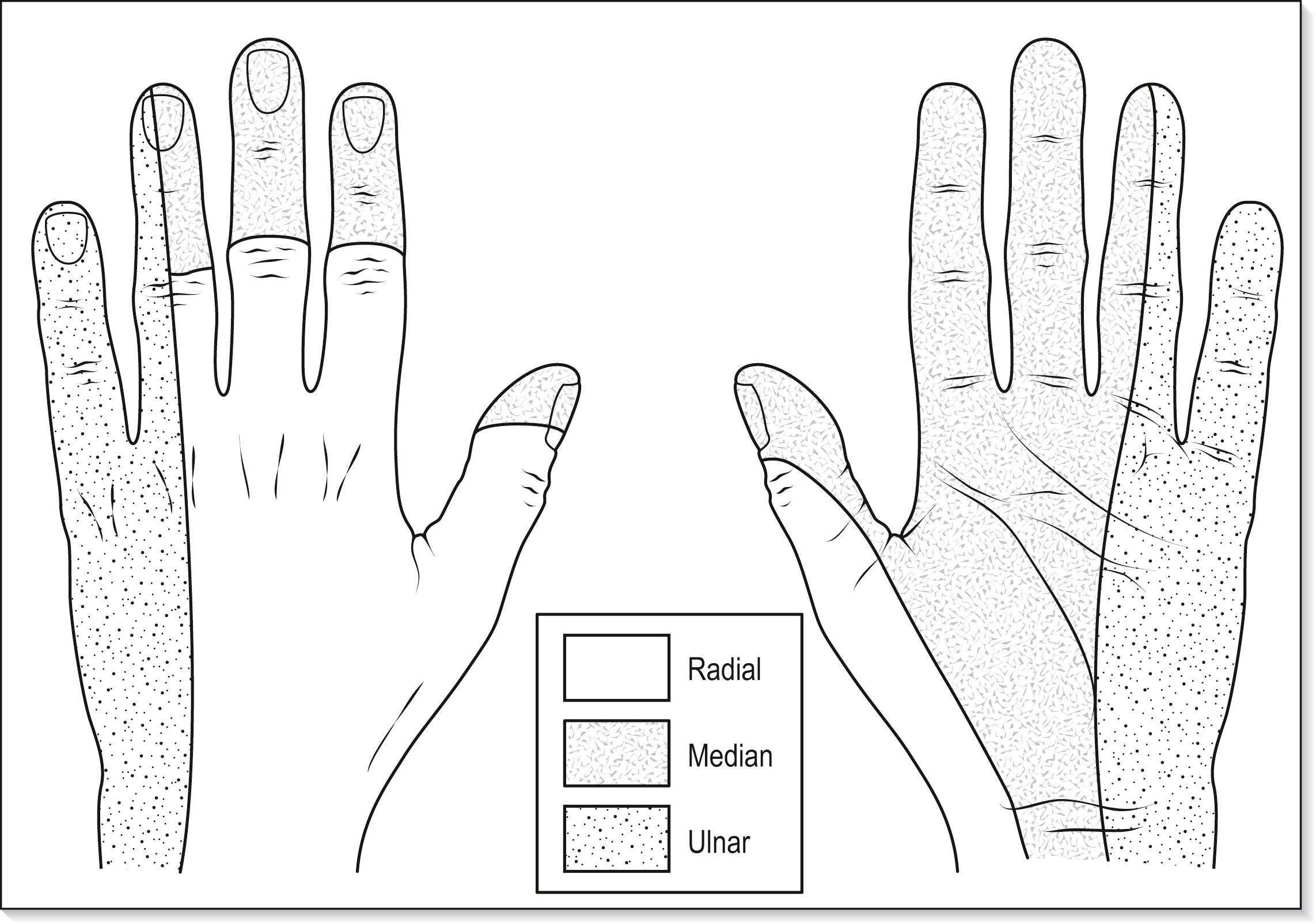Physical Address
304 North Cardinal St.
Dorchester Center, MA 02124
Hand injuries are common, and most, if treated early and competently, carry a good prognosis.
A comprehensive knowledge of hand anatomy and function is essential for appropriate management of the injured hand.
Aftercare and rehabilitation, ideally with specialized hand therapists, are essential for return to normal function.
Hand injuries are common causes of presentation to emergency departments (EDs). The most common injuries are wounds (∼50%), fractures (∼15%), sprains (∼8%), contusions (∼8%). Males injure their hands more often than females. The complex anatomy and tactile function of the hand mean that hand injuries can profoundly affect an individual’s activities of daily life. The importance of the correct assessment and care of hand injuries cannot be overstated. Apart from the initial pain and trauma, occupational and psychological concerns play a major role in the aftermath of these injuries. Even a relatively minor fingertip injury can cause an individual being away from work for several days, with consequent loss of earnings and concerns for long-term function and appearance. A detailed knowledge of the anatomy of the hand and its common injuries is essential to proper diagnosis and management. The role of ED management is as much about identifying cases that require specialist referral as it is about treating straightforward injuries.
Time taken eliciting a focused history of the mechanism of injury is essential in cases of hand injury. Key questions include the following:
When did the injury occur?
What was the position of the hand at the time?
Was the hand injured with a sharp implement, such as glass, or crushed in a machine? Incised wounds caused by sharp implements tend to damage structures such as nerves and tendons, whereas crush injuries may cause fractures and lacerations.
Was there brisk bleeding and does any part of the hand feel numb? These symptoms are important as, in the fingers, the digital nerves lie adjacent to the arteries.
In what environment did the injury occur? Is it likely that the wound is contaminated or contains foreign material, such as glass?
The patient’s hand dominance should be noted, as well as his or her occupation and key leisure activities. These details will have to be considered by the physician and patient when a management plan is being decided upon. Tetanus prophylaxis status should be determined.
The injured hand must be examined in a well-lit area. Overhead lighting and headlamps should be used if required. Temporary dressings may have to be soaked off if they have been allowed to dry out and become adherent. At triage, an initial moist dressing is preferred. Firm pressure and elevation will invariably arrest even brisk bleeding.
A standardized hand examination is recommended to ensure completeness.
Hand and finger injuries are painful; therefore suitable analgesia should be given prior to full examination. Local infiltration of a local anaesthetic without adrenaline around a wound or as a digital nerve block will allow examination of all aspects except sensation. It is imperative that sensation be tested and recorded prior to anaesthesia, as is palpating for specific areas of tenderness. A wrist block is useful when some or all of the hand must be anaesthetized ( Fig. 4.5.1 ). In this instance, a longer-acting local anaesthetic is generally used to prolong the effect.

Inspection of the hand and comparing it with the other side will give information on local swelling and bruising, wounds and bleeding, deformity, misalignment, amputation. Discolouration may give information about perfusion of the tissues. The resting position of the hand may be a clue to tendon injury, as the normal uninjured position is held with the fingers in increasing flexion from the index to the little finger ( Fig. 4.5.2A ). A pointing finger may indicate a flexor tendon injury (see Fig. 4.5.2B ). Obvious bone or joint deformity should be recorded.

Testing sensation is achieved by point touch in the distribution of the three main nerves that supply the hand ( Fig. 4.5.3 ). Testing sensation of individual digits is necessary to elicit digital nerve injury. The median nerve supplies the palmar aspect of the thumb, index, middle and half of the ring finger, extending to supply the fingertip and nail bed. The ulnar nerve supplies both palmar and dorsal aspects of the other half of the ring finger and the little finger. The radial nerve supplies the radial dorsum of the hand, thumb, index, middle and radial aspects of the ring finger. If the patient is unable to describe sensation because he or she is too young or is unconscious, it is useful to remember that the digital nerves also carry the sympathetic supply to the fingers and that division will cause a dry finger in the distribution of the digital nerve. The motor components of median, ulnar and radial nerves are tested with resistance to thumb opposition, adduction and extension, respectively.

The metacarpals and phalanges are all easily palpable subcutaneously, and local tenderness or crepitus may indicate underlying fracture. Ligamentous stability should be tested with valgus and varus stress on the proximal interphalangeal (PIP), distal interphalangeal (DIP) and metacarpophalangeal joints (MCPJs). Gamekeeper’s or skier’s thumb (in which there is insufficiency of the ulnar collateral ligament of the thumb) is a common ligamentous injury.
Functional testing should be performed for all injured hands. Tendon integrity is tested by asking the patient to perform specific movements. Some tendon injuries may be obvious; however, two flexor tendons supply each finger, and simply asking the patient to flex the finger will not exclude a divided flexor digitorum superficialis tendon. The profundus tendon flexes the distal interphalangeal joint (DIPJ) and is tested by asking the patient to flex the tip of each finger in turn while the examiner holds the proximal interphalangeal joint (PIPJ) in extension. The superficialis flexor tendon is tested by asking the patient to flex each finger individually while the examiner holds the other fingers straight. The extensor tendons to the fingers are tested by asking the patient to extend the fingers against resistance. It is important to remember that the broad interconnections between the extensor tendons make it possible to extend to near neutral in the presence of a divided tendon. Partial tendon injuries may still exist despite normal functioning of the fingers. A functioning hand should allow full extension of all fingers and comfortable flexion of the fingers into the palm.
Displaced fractures or dislocations may be apparent as deformity. More subtle rotational deformity will be detected by a finger crossing its neighbour when flexed and testing for this is important.
Most information will be obtained from a focused history and examination. Radiology of the hand and fingers will be necessary if bone/joint deformity or tenderness is elicited. Even obvious dislocations should be x-rayed prior to correction, as post-reduction x-rays may be overly reassuring despite significant soft tissue damage. Glass is radiopaque to a varying degree, and if a wound is caused by glass, an x-ray should be done prior to closure. Organic foreign bodies and infections may be detected by ultrasound using a small-parts soft tissue probe, and this modality is commonly available in the ED. Ultrasound is also useful to establish tendon integrity, but this is a more specialized examination.
Magnetic resonance imaging (MRI) can be useful in selected injuries as it shows the soft tissues of the hand clearly, but it is relatively unavailable acutely and should be reserved for conditions where emergent treatment is dependent on the integrity of the soft structures in the hand, which are not apparent on examination alone.
Appropriate analgesia should be provided, as previously described. Rings should be removed from injured fingers to prevent subsequent compromise of circulation as the finger swells. Irrigating wounds with tap water does not increase the risk of infection and is economic. Simple hand and finger wounds can be treated along conventional lines with judicious use of local anaesthetic and skin approximation with fine (5.0) sutures or skin closures. Hand wounds generally heal well and conservative management of small, uncomplicated hand wounds in areas of low skin tension is appropriate. Digital nerve block is useful for managing finger injuries. This technique involves infiltrating local anaesthetic around the digital nerve at the base of the finger or in the palm. Approaching the digital nerve from the dorsum of the finger is less painful, but the palmar approach is more accurate, as the digital nerves lie just deep to the palmar aponeurosis. A short fine-gauge (e.g. 30 gauge) needle is used with small amounts (∼1 mL) of local anaesthetic for each nerve. Choice of anaesthetic will depend on the desired length of effect, and consideration should be given to using long-acting agents for crush or bone injury when a prolonged analgesic effect is desirable. Studies have shown that the use of adrenaline with lignocaine is safe and also prolongs the anaesthetic effect.
Hand dressings can be held in place with a conforming crepe bandage to provide a degree of compression. Stable injuries to the fingers can be managed with ‘buddy’ strapping, which allows for some joint movement. Elevation is essential after hand injury to reduce swelling. Minor injuries can be successfully managed in the ED, but more significant injuries usually require referral for surgical opinion.
Become a Clinical Tree membership for Full access and enjoy Unlimited articles
If you are a member. Log in here